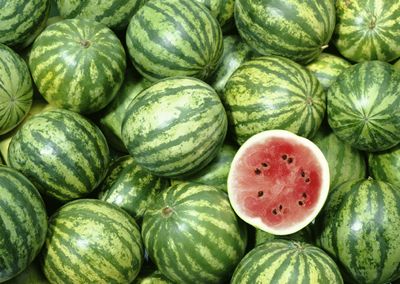How to Plant, Grow, and Harvest Watermelon
Are you ready to learn how to plant, grow, and harvest watermelon, the delicious and tender warm-season vegetable? Read on to learn about seed spacing, harvesting techniques, commons problems, and more.

When to Plant
Plant after the soil is warm and when all danger of frost is past. Watermelons grow best on a sandy loam soil, although yields on clay soils can be increased significantly by mulching raised planting rows with black plastic film.
Spacing & Depth
Watermelon vines require considerable space. Plant seed one inch deep in hills spaced 6 feet apart. Allow 7 to 10 feet between rows. Plant single transplants 2 to 3 feet apart or double transplants 4 to 5 feet apart in the rows. Some smaller varieties can even be trained up a trellis which makes tending and harvesting a cinch!
Care
Mulching watermelons with black plastic film will promote earliness by warming the soil beneath the plastic. Floating row covers moderate temperatures around the young plants, providing some frost protection in unseasonable cold spells.
Watermelons should also be kept free from weeds by shallow hoeing and cultivation. The plants have moderately deep roots and watering is seldom necessary unless the weather turns dry for a prolonged period. In cooler areas, experienced gardeners may find floating row covers, drip irrigation and black plastic mulch advantageous in producing a good crop in a short season.
Harvesting
Many home gardeners experience difficulty in determining when watermelons are ripe. Use a combination of the following indicators: (1) light green, curly tendrils on the stem near the point of attachment of the melon usually turn brown and dry; (2) the surface color of the fruit turns dull; (3) the skin becomes resistant to penetration by the thumbnail and is rough to the touch; and (4) the bottom of the melon (where it lies on the soil) turns from light green to a yellowish color. These indicators for choosing a ripe watermelon are much more reliable than "thumping" the melon with a knuckle. Many watermelons do not emit the proverbial "dull thud" when ripe. For these, the dull thud may indicate an over-ripe, mushy melon.
Common Problems - Cucumber beetles attack watermelon plants. Use an organic spray like Captain Jack's Deadbug to eliminate pests and protect the fruits of your labor.
